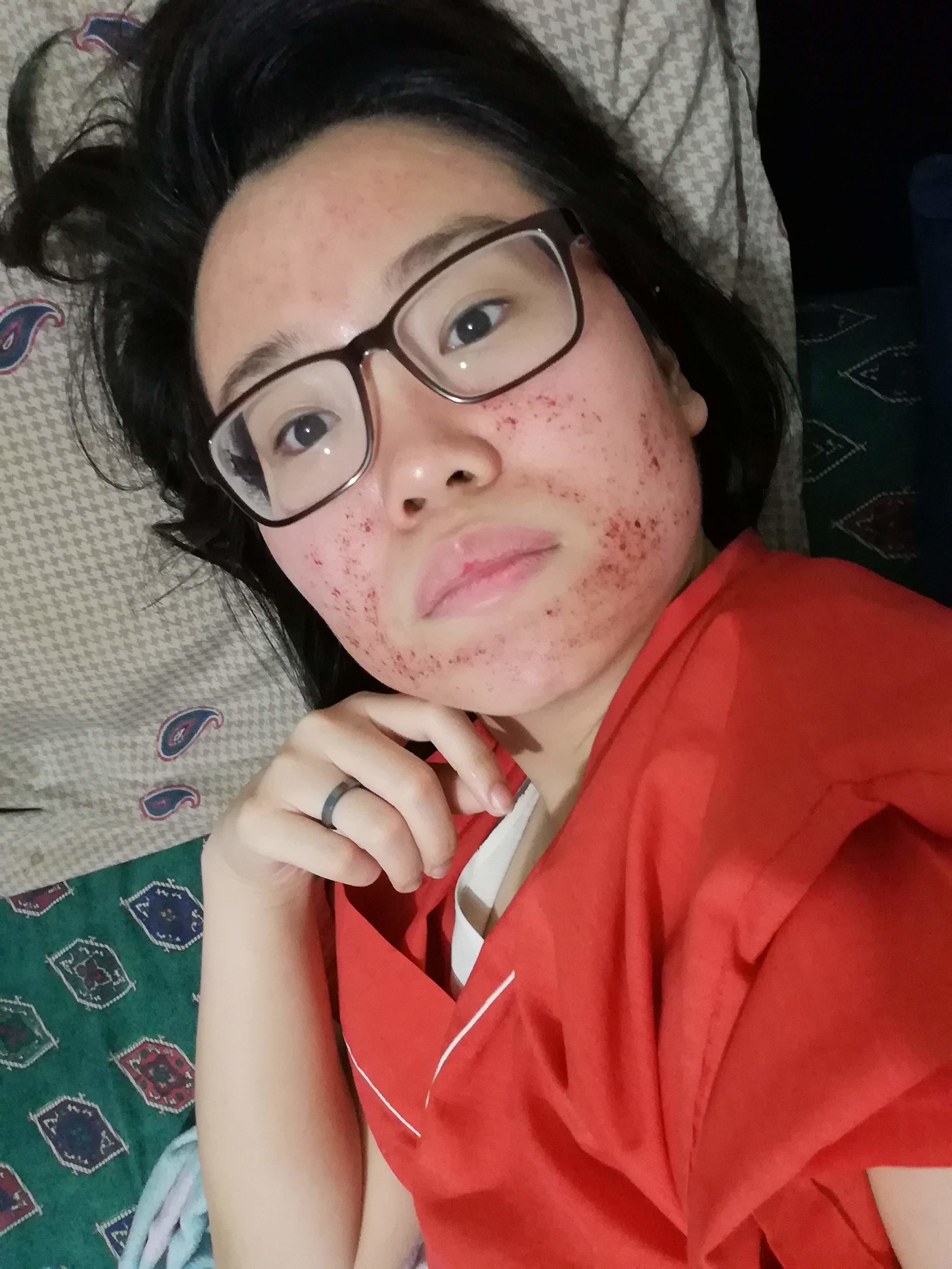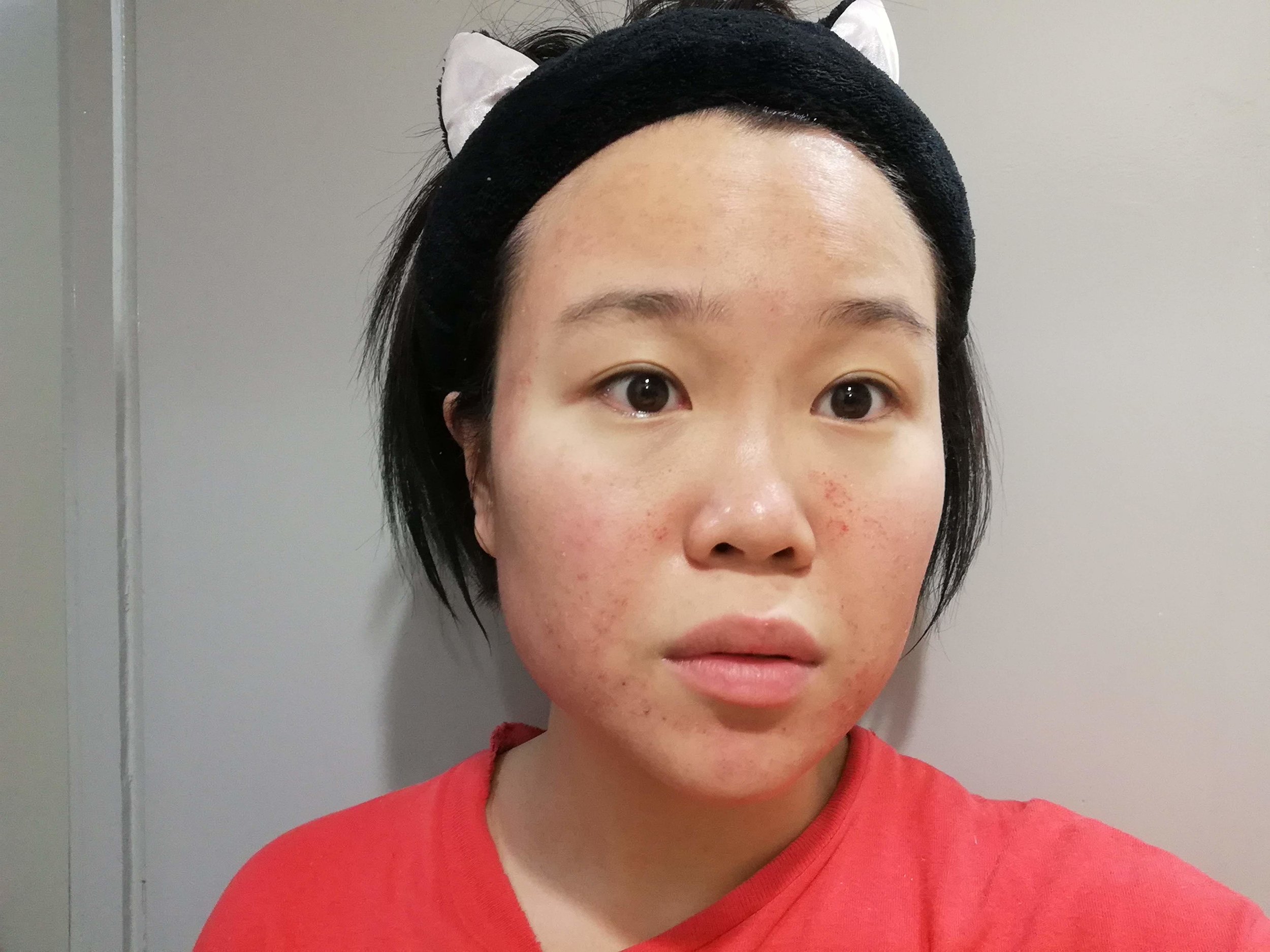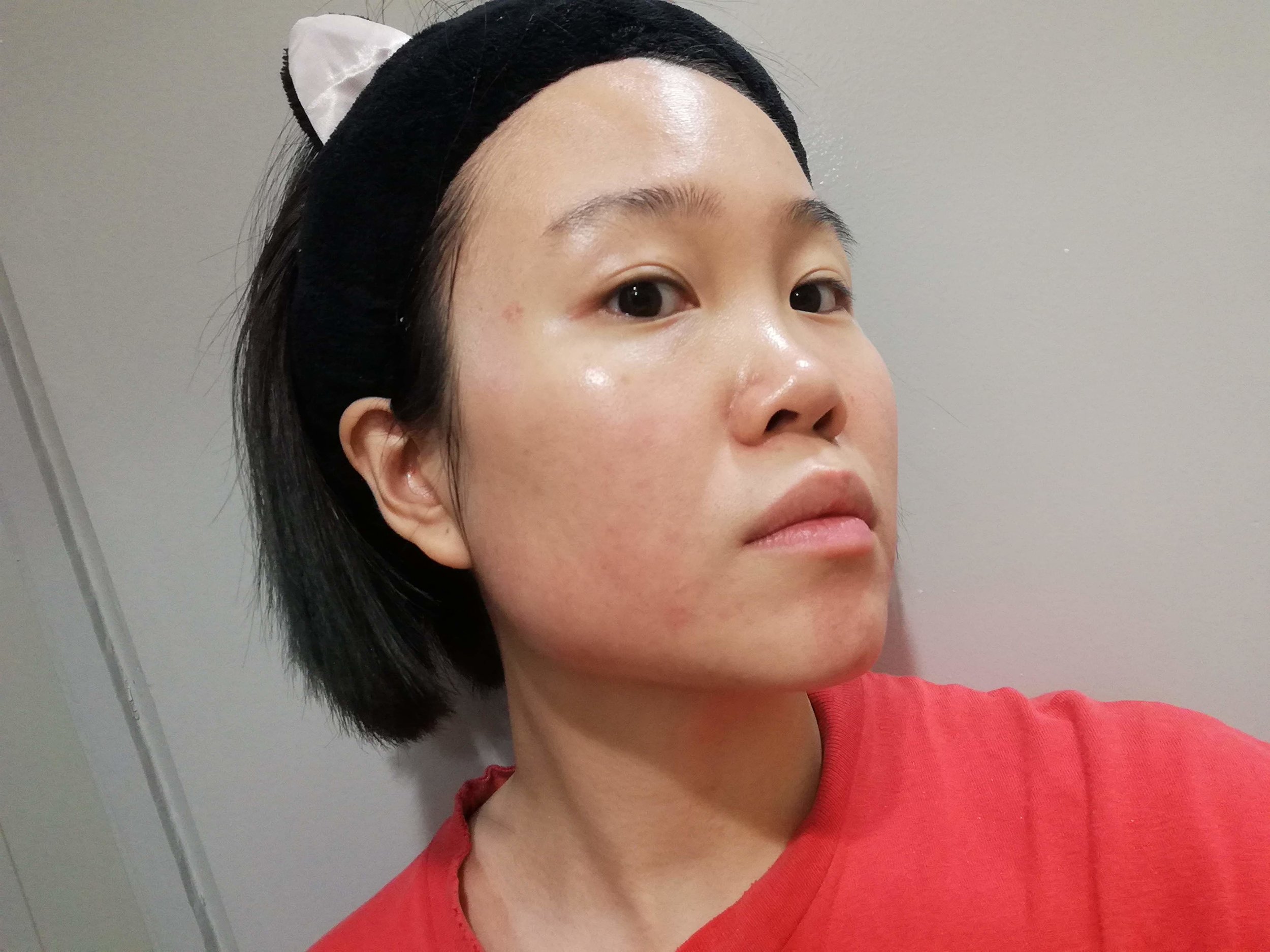A needle-phobe tries microneedling: Does it actually work?
A few months ago, I started using adapalene, a third-generation retinoid that was recently approved for over-the-counter use. Supposedly, a Reddit user banished her textured skin and blackheads in just one month, using daily exfoliation and this “miracle” retinoid gel.
Despite the warnings every single website about adapalene mentions that it’s really only for cystic acne, and that skin will become dry and sensitive for up to two months - a process that is called “retinization” - I bought the product, began using it, and experienced the four worst weeks of my life, skin-wise. I broke out, my skin texture got worse, and there was little pore minimization. Eventually, I threw in the towel, learning that, even if I was technically using something OTC-approved, messing around with dermatologist-grade topical products should always be supervised by a professional.
My retinized skin included rough texture, a scab on my right cheek, and flakes around my mouth
Afterwards, my face was never quite the same. I technically have oily skin, but weeks after I’d stopped with my retinoid, I still had dry patches, to the point that it made sense to switch out my gel moisturizers for heavy, emollient creams. My skin felt textured and dry to touch, and I could never quite get any of my foundations to lie flat.
By this point, I was just desperate to have my old skin back. What I didn’t expect, though, was just how dramatic a process I’d undergo to get there.
These needles go into my face
Microneedling is a popular dermatological procedure that is designed to stimulate the body’s natural production of collagen. It’s usually done to prevent/treat acne scarring and/or fine wrinkles, and promises both increased penetration for skincare actives (especially vitamin C serums) and skin whose appearance continuously improves for up to three weeks after treatment, thanks to the continued collagen cycle.
The catch? As the name suggests, it involves tiny needles being punched into your face. And yes, there will be blood.
As someone who is absolutely terrified of needles, I would not have looked into microneedling at all, if not for the current state of my skin. That being said, all my research into the procedure promised the process itself was (relatively) painless, and down-time was short, so I booked my appointment with the CocktailsMD Wellness Lounge in Festival Mall, Alabang.
CocktailsMD is the brainchild of Dr. Joseph De Leon, a cosmetic surgeon, aesthetic dermatologist, anti-aging physician, and integrative health specialist. Located in Festival Mall’s Wellness Lane (New Level 2/Old Level 3), the clinic specializes in vitamin drips and vitamin shots (the “cocktails” of the name), but also offers a wide range of noninvasive services, such as fillers, threadlifts, and even microneedling’s celebrity cousin, the PRP “vampire” facial.
Of these noninvasive services, microneedling is among the most affordable. Its regular price is P2,500 but it comes out to only P1,800 if you use a Deal Grocer voucher! As a lifestyle deals site, Deal Grocer is heavily curated to feature only premium offers from their roster of 500+ exclusive brand partners.
I was actually more familiar with Deal Grocer for its resort- and hotel-related offers, but was pleasantly surprised to discover it had an extensive array deals on of beauty- and wellness-related services as well. The site has deals on everything from lash extensions to non-invasive liposuction, so there really is something for everyone!
Dr. Joseph De Leon, head of CocktailsMD
Before my treatment, I had a quick sit-down with Doc Joseph, who explained the steps of the microneedling procedure. First, my face would be treated with topical anesthetic to numb the skin in preparation for the needling proper. Next, I’d have the actual “needling” process, which would take no more than fifteen minutes. To finish the session, I’d get a quick facial mask treatment. I would also be getting a tub of healing cream for my aftercare. The whole process would - and did - take just a little over an hour. Armed with information and steadied nerves, I dove in.
Getting local anesthesia on my face
Microneedling is conducted in one of two ways: via dermarolling and via dermapen. Dermarollers are the more familiar technique, as they can be purchased for at-home treatment. However, the ones available on the market do not penetrate the skin much; the needles are only half a millimeter at best so they aren’t as effective. Professional microneedling uses needles that can penetrate up to 3 millimeters, such as those in the Dermapen that CocktailsMD uses. This device looks much like a sealed tattoo tool, and pumps needles into your skin. The sensation, combined with the numbing of anesthesia, feels a little like an electric toothbrush being buffed all over the skin.
After prepping my skin with a serum, Doc Joseph started the procedure by running the pen over my forehead. Since the forehead is literally just skin and bone (no fat), the needles used on this area do not penetrate as deeply as on the cheeks and around the mouth (but more on those later). Still, without the fat layer to cushion the blow, you may feel a bit of stinging due to the needle vibrating over bone. It’s not painful, but it’s not pleasant.
Once my forehead was done, it was time to go over the cheeks, jaw, and chin. Doc Joseph spent significantly more time on these areas, going over them over and over and allowing the needles to penetrate deeper. I noticed that he seemed to be targeting the areas where I experienced the most dryness and and flaking: around the mouth and just below my cheeks. Due to the “fat reserves” I had in these areas, the dermapen felt exactly like an electric toothbrush scrubbing my face (down to the whirring sound), so imagine my shock when, once done, Doc Joseph allowed me to check the “results” before he cleaned up my face. It looked like I had the infamous The Ordinary AHA + BHA Peeling Mask on! Do note that I just had to see so I could report it for this story but they normally clean up your skin quickly afterwards so you don’t see any blood at all.
A thin solution of TCA (trichloroacetic acid) was applied before being set in place with a sheet mask. I have to admit this was probably my least favorite part of the procedure: the sheet mask + acid “facial” stung for the better part of five minutes. The pain left me winded, but quickly subsided, and soon I was at the front desk, getting my aftercare briefing from Doc Joseph and Nurse Andrea.
As far as derma procedures go, microneedling is relatively low maintenance in terms of aftercare. Since your skin will be on the raw side, you’ll want to avoid direct sun exposure (that means no beach trips!), as well as any alcohol-based toners and acids for about a week. Instead, layer on serums, as the micro-channels created by the needles makes any skincare that you apply sink deeper into the skin. I took a quick test at CocktailsMD’s front desk, and got “matched” to the ideal serum ingredient for my skin condition, which was (unsurprisingly) vitamin C, a building block for collagen.
I was also given, as part of my treatment package, a small tub of proprietary post-treatment cream - infused with steroids, hyaluronic acid, and growth factor - that I could use in lieu of moisturizer for the week. I was also given two hydrating sheet masks, and instructed to use them for the first few days if I felt any tenderness and dryness. I definitely did on that first day!
Serums are recommended for aftercare
Aside from the sheet masks and the post-treatment cream (both of which are given as part of the treatment package), the rest of the products I used in my skincare were stuff I already had at home, but that the doctor approved for use during the recovery period. Nothing fancy here: just good old Cetaphil Gentle Skin Cleanser, a vitamin C serum (that I purchased from CocktailsMD to replace my empty Dear Klairs), and an alcohol-free toner.
I was told that, as far as procedures go, microneedling had one of the shortest “down-times.” But it honestly did not feel short to me! My face had a pattern of bruising and redness, and the scabbing looked like actual holes in my face. My cheeks (where the bruising was the worst) also puffed up a bit, making me look as if I’d gained weight (though the swelling went down eight days later).
Considering this, I really do suggest getting this treatment done right before a long holiday, when you can stay home the entire recovery period, because I felt very conscious about how my skin looked. I could definitely empathize with Liz’s experience of getting the Obagi Blue Peel! Aesthetic issues aside though, the down-time wasn’t terrible. Aside from some slight tightness the morning after, and dramatic peeling on days 3 to 5, there was little to no discomfort. In fact, I enjoyed how my skin felt: my face was smooth to touch, especially on my cheeks and the bridge of my nose!
It actually took a little longer than a week for the last bits of redness to go down, but I was already able to use makeup by day 5 of recovery, so I looked more like myself when out and about. Once I stopped using the healing cream, the swelling of my face subsided as well.
12 days later, wearing just moisturizer!
Finally, the million dollar question: was microneedling worth it? While my skin is definitely not poreless or totally flawless, I can definitely say that, at a little under two weeks in, my face has improved from its pre-needled, post-adapalene state! The skin on my cheeks, chin, and nose are smoother to touch, though you can still see some slight redness and a faint demarcation line along my jaw from the needling. I also happen to be a few days away from the start of my period, which might explain the slight breakout on my forehead, though those are supposedly also a common side-effect post-procedure. Anyway, it’s nothing a little In Her Element Spot Control Oil can’t fix.
What I’m most satisfied with is how smoothly my makeup glides on, and how it looks like on my skin! Whereas before, any sort of makeup base would tend to pill and flake, highlighting my skin’s texture, now my base looks seamless. My skin on its own is also nice enough that I find myself reaching for sheerer BB creams instead of full-coverage products.
Back to wearing makeup by Day 5: I have a face base, contour, illuminator, and pigments on
Despite my fear of needles, I would say that microneedling is worth trying. I’m one month in, and my skin is definitely less textured, especially around the nose and cheek area. Barring a few hormonal breakouts, it is also remarkably clear. The best part? Post-microneedling, my skin seems to have become less sensitive to using AHAs. They used to leave my skin feeling dry and flaky, but now I’m left with all the benefits and none of the side effects. I wonder if this means the collagen production caused by microneedling also improved my skin’s resilience? Either way, I'm not complaining. I enjoy how well my foundations set on my face, and the fact that I can once again use sheerer, more illuminating formulas without fear of any flaking showing through!
A caveat: I am far from the “ideal” microneedling client. To start with, my skin didn’t have a ton of acne scarring, hyperpigmentation, or fine lines: conditions that microneedling is best suited to treating. From the beginning, Doc Joseph admitted than microneedling would generally be a preventative procedure for me, rather than a corrective one. If you have visible hyperpigmentation, acne scars, or fine wrinkles, you will probably see more dramatic results, though these would usually come over a series of sessions, instead of just one treatment.
Totally bare-faced!
If the downtime period doesn’t faze you, I’d probably also recommend microneedling even if you have skin like mine, as I have seen enough results to conclusively say my skin is “rebooting.” You can go in once every quarter for maintenance, though those with scars and fine lines may want to try increasing their frequency to every four to six weeks, for maximum effect. It’s a worthwhile investment as the skin improvement is still faster than what you would get from skincare products alone and is more long-term as well, and you can get it for much less from Deal Grocer.
This microneedling session, along with the aftercare products, is normally priced at P2,500 but it’s available for just P1,800 via Deal Grocer. That’s quite affordable considering this is a medical-grade facial treatment! Beauty treatments and services can cost a pretty penny but Deal Grocer helps you be savvy about your beauty spending. They have promos on everything from haircuts and manicures to laser sessions, so I highly suggest checking out the site if there are any beauty treatments that might interest you.
What about you? Would you like to try microneedling? Have any questions about it? Sound off in the comments below!
CocktailsMD is located at 2/F Wellness Lane, Festival Mall, Filinvest Corporate City, Alabang. You may inquire and book an appointment by calling (0917) 907 2112 or emailing cocktailsmd.msc@gmail.com
This story is brought to you by Deal Grocer. Deal Grocer offers exclusive limited-time offers on travel, fitness, dining, and beauty services to its members from over 500 brand partners. Sign up is free at DealGrocer.com

















